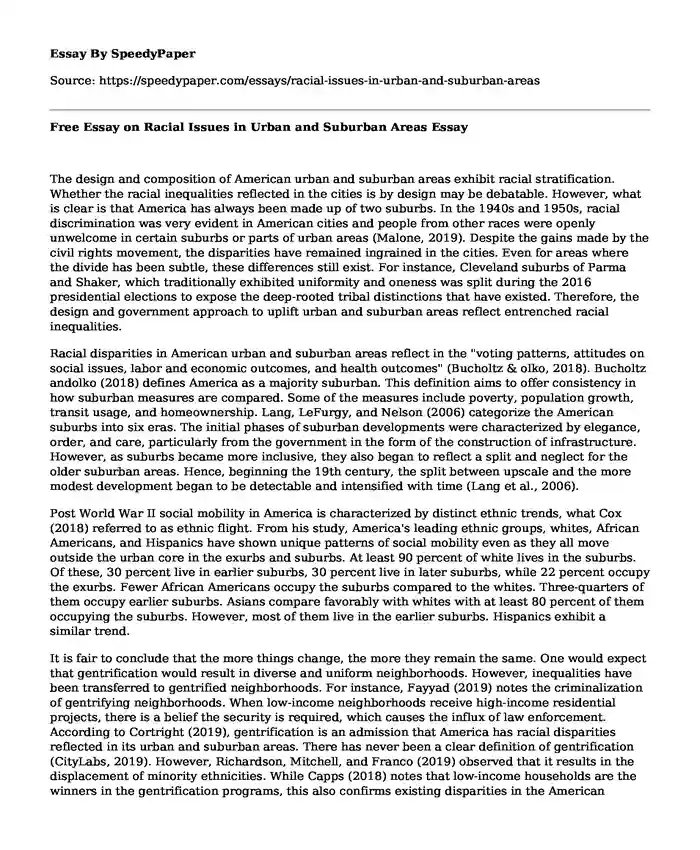
| Type of paper: | Essay |
| Categories: | Race Discrimination Community Social issue |
| Pages: | 4 |
| Wordcount: | 869 words |
The design and composition of American urban and suburban areas exhibit racial stratification. Whether the racial inequalities reflected in the cities is by design may be debatable. However, what is clear is that America has always been made up of two suburbs. In the 1940s and 1950s, racial discrimination was very evident in American cities and people from other races were openly unwelcome in certain suburbs or parts of urban areas (Malone, 2019). Despite the gains made by the civil rights movement, the disparities have remained ingrained in the cities. Even for areas where the divide has been subtle, these differences still exist. For instance, Cleveland suburbs of Parma and Shaker, which traditionally exhibited uniformity and oneness was split during the 2016 presidential elections to expose the deep-rooted tribal distinctions that have existed. Therefore, the design and government approach to uplift urban and suburban areas reflect entrenched racial inequalities.
Racial disparities in American urban and suburban areas reflect in the "voting patterns, attitudes on social issues, labor and economic outcomes, and health outcomes" (Bucholtz & olko, 2018). Bucholtz andolko (2018) defines America as a majority suburban. This definition aims to offer consistency in how suburban measures are compared. Some of the measures include poverty, population growth, transit usage, and homeownership. Lang, LeFurgy, and Nelson (2006) categorize the American suburbs into six eras. The initial phases of suburban developments were characterized by elegance, order, and care, particularly from the government in the form of the construction of infrastructure. However, as suburbs became more inclusive, they also began to reflect a split and neglect for the older suburban areas. Hence, beginning the 19th century, the split between upscale and the more modest development began to be detectable and intensified with time (Lang et al., 2006).
Post World War II social mobility in America is characterized by distinct ethnic trends, what Cox (2018) referred to as ethnic flight. From his study, America's leading ethnic groups, whites, African Americans, and Hispanics have shown unique patterns of social mobility even as they all move outside the urban core in the exurbs and suburbs. At least 90 percent of white lives in the suburbs. Of these, 30 percent live in earlier suburbs, 30 percent live in later suburbs, while 22 percent occupy the exurbs. Fewer African Americans occupy the suburbs compared to the whites. Three-quarters of them occupy earlier suburbs. Asians compare favorably with whites with at least 80 percent of them occupying the suburbs. However, most of them live in the earlier suburbs. Hispanics exhibit a similar trend.
It is fair to conclude that the more things change, the more they remain the same. One would expect that gentrification would result in diverse and uniform neighborhoods. However, inequalities have been transferred to gentrified neighborhoods. For instance, Fayyad (2019) notes the criminalization of gentrifying neighborhoods. When low-income neighborhoods receive high-income residential projects, there is a belief the security is required, which causes the influx of law enforcement. According to Cortright (2019), gentrification is an admission that America has racial disparities reflected in its urban and suburban areas. There has never been a clear definition of gentrification (CityLabs, 2019). However, Richardson, Mitchell, and Franco (2019) observed that it results in the displacement of minority ethnicities. While Capps (2018) notes that low-income households are the winners in the gentrification programs, this also confirms existing disparities in the American suburbs as most of the low-income are minority ethnicities.
In conclusion, the design and government approach to uplift urban and suburban areas reflect entrenched racial inequalities. As suburbs became more inclusive, they also began to reflect a split and neglect for the older suburban areas. Hence, beginning in the 19th century, the split between upscale and more modest development began to be detectable and intensified with time. America's leading ethnic groups, whites, African Americans, and Hispanics have shown unique patterns of social mobility even as they all move outside the urban core in the exurbs and suburbs. When low-income neighborhoods receive high-income residential projects, there is a belief that security is required, which causes the influx of law enforcement
References
Bucholtz, S., & olko, J. (2018). Most Americans Describe Where They Live As Suburban. Retrieved 16 December 2019, from https://www.citylab.com/life/2018/11/data-most-american-neighborhoods-suburban/575602/
Capps, K. (2018). The Hidden Winners in Neighborhood Gentrification - CityLab. Retrieved 16 December 2019, from https://www.citylab.com/equity/2019/07/gentrification-effects-neighborhood-data-economic-statistics/594064/
CityLabs. (2019). No One's Very Good at Correctly Identifying Gentrification. Retrieved 16 December 2019, from https://www.citylab.com/equity/2014/12/no-ones-very-good-at-correctly-identifying-gentrification/383724/
Cortright, J. (2019). City Observatory - Everything that causes gentrification, from A to Z. Retrieved 16 December 2019, from http://cityobservatory.org/everything-that-causes-gentrification-from-a-to-z/
Cox, W. (2018). Ethnic Flight | Newgeography.com. Retrieved 16 December 2019, from http://www.newgeography.com/content/006079-ethnic-flight
Fayyad, A. (2019). The Criminalization of Gentrifying Neighborhoods. Retrieved 16 December 2019, from https://www.theatlantic.com/politics/archive/2017/12/the-criminalization-of-gentrifying-neighborhoods/548837/
Lang, R., LeFurgy, J., & Nelson, A. C. (2006). The six suburban eras of the United States research note. Opolis, 2(1). Retrieved from https://cloudfront.escholarship.org/dist/prd/content/qt739425j0/qt739425j0.pdf
Malone, C. (2019). A Tale of Two Suburbs. Retrieved 16 December 2019, from https://fivethirtyeight.com/features/a-tale-of-two-suburbs/
Richardson, J., Mitchell, B., & Franco, J. (2019). Shifting neighborhoods: gentrification and cultural displacement in American cities. National Community Reinvestment Coalition. Retrieved from https://www.printfriendly.com/p/g/KAA9
MjSen, C. (2018). Bloomberg - Are you a robot? Retrieved 16 December 2019, from https://www.bloomberg.com/opinion/articles/2018-04-03/millennials-moving-to-suburbs-will-change-economic-development
Cite this page
Free Essay on Racial Issues in Urban and Suburban Areas. (2023, Mar 19). Retrieved from https://speedypaper.com/essays/racial-issues-in-urban-and-suburban-areas
Request Removal
If you are the original author of this essay and no longer wish to have it published on the SpeedyPaper website, please click below to request its removal:
- Essay Example on Why Psychology Is Not a Science
- Terrorism Essay Example
- Free Essay on Porter's Competitive Strategies
- Role of Arbitrators in the Resolution of Commercial Disputes - Paper Example
- Essay Example: The Proofs for Theft in a Court of Law
- Essay Sample: Threats to Home Security
- Essay Sample on Innovating and Creating the Packaging. Patagonia
Popular categories




